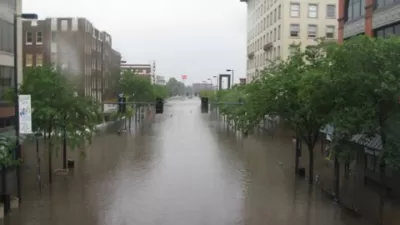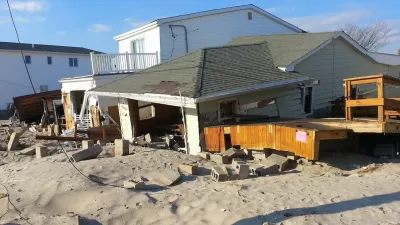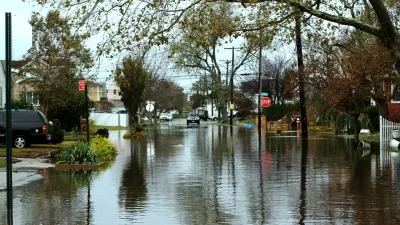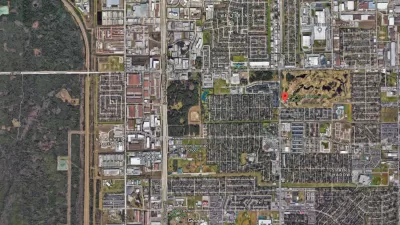Reporting from Cedar Rapids, Iowa, where a 2008 flood devastated 14% of this city of 126,000, John Eligon writes of the extensive rebuilding that has occurred in the flood plain - largely without protection from future floods.

The city's website documents the magnitude of the flooding of the Cedar Rapids River, which "crested to its highest level in Cedar Rapids history on June 13, 2008. The flood waters penetrated 10 square miles or 14 percent of the city. This monumental flood impacted 7,198 parcels, including 5,390 houses, dislocated more than 18,000 residents and damaged 310 City facilities. More flood facts."
Funds of up to $307 million for the rebuilding have flowed from federal, state, and local sources "to redevelop flood-affected public facilities". However, residents rejected - twice - "extending a one-cent sales tax to pay for flood protection". Eligon did not discuss the role that flood insurance played in the rebuilding effort.
There are those who question the extent of the rebuilding considering it's vulnerable location. The essential question facing Cedar Rapids and other cities who "are grappling with competing interests as they work to recover from such disasters: do they restore and rebuild what nature wiped out or do they cede to natural forces and leave waterfronts alone?"
In Cedar Rapids, the economic forces appear too strong to allow nature a stronger role in the flood's aftermath.
When floods wipe out an urban area, city officials tend to favor quick redevelopment to prevent irreparable economic harm, especially in this part of the country.
After the flood, the city bought and demolished about 1,400 homes, but is building 1,311 new housing units within the flood-affected area.
“Somehow we’ve grown into this belief that we have an entitlement for a community to stay exactly where it is,” said Larry Larson, the senior policy adviser for the Association of State Floodplain Managers.
While "there is a growing chorus of conservationists and public officials who say that some land, no matter how prime it is for real estate, might be best returned to nature", they appear to have lost out to the rebuilders. Their warning that "it makes little sense to rebuild in flood-prone areas that will require taxpayer bailouts when the water rises again" is often drowned out by those who want to restore their community, including city officials.
“The alternative to just stay still, to not rebuild, to allow our city to basically fumble in its core just doesn’t make sense for our city,” said Jeff Pomeranz, the Cedar Rapids city manager.
Yet, there are alternatives. "Nearby Cedar Falls, for instance, passed an ordinance after the 2008 flooding that restricted development within the 500-year flood plain."
FULL STORY: Iowa City Rebuilds From Flooding but Remains Vulnerable

Planetizen Federal Action Tracker
A weekly monitor of how Trump’s orders and actions are impacting planners and planning in America.

Map: Where Senate Republicans Want to Sell Your Public Lands
For public land advocates, the Senate Republicans’ proposal to sell millions of acres of public land in the West is “the biggest fight of their careers.”

Restaurant Patios Were a Pandemic Win — Why Were They so Hard to Keep?
Social distancing requirements and changes in travel patterns prompted cities to pilot new uses for street and sidewalk space. Then it got complicated.

Platform Pilsner: Vancouver Transit Agency Releases... a Beer?
TransLink will receive a portion of every sale of the four-pack.

Toronto Weighs Cheaper Transit, Parking Hikes for Major Events
Special event rates would take effect during large festivals, sports games and concerts to ‘discourage driving, manage congestion and free up space for transit.”

Berlin to Consider Car-Free Zone Larger Than Manhattan
The area bound by the 22-mile Ringbahn would still allow 12 uses of a private automobile per year per person, and several other exemptions.
Urban Design for Planners 1: Software Tools
This six-course series explores essential urban design concepts using open source software and equips planners with the tools they need to participate fully in the urban design process.
Planning for Universal Design
Learn the tools for implementing Universal Design in planning regulations.
Heyer Gruel & Associates PA
JM Goldson LLC
Custer County Colorado
City of Camden Redevelopment Agency
City of Astoria
Transportation Research & Education Center (TREC) at Portland State University
Camden Redevelopment Agency
City of Claremont
Municipality of Princeton (NJ)





























